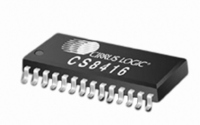CS8416-CNZ Cirrus Logic Inc, CS8416-CNZ Datasheet - Page 17

CS8416-CNZ
Manufacturer Part Number
CS8416-CNZ
Description
IC RCVR DGTL 192KHZ 28QFN COMM
Manufacturer
Cirrus Logic Inc
Type
Digital Audio Interface Receiverr
Datasheet
1.CS8416-CZZ.pdf
(60 pages)
Specifications of CS8416-CNZ
Applications
Digital Audio
Mounting Type
Surface Mount
Package / Case
28-QFN
Audio Control Type
Digital
Control Interface
I2C, SPI
Control / Process Application
AV & DVD Receivers, CD-R, Digital Mixing Consoles
Supply Voltage Range
3.13V To 5.25V, 3.13V To 3.46V
Lead Free Status / RoHS Status
Lead free / RoHS Compliant
For Use With
598-1017 - BOARD EVAL FOR CS8416 RCVR
Lead Free Status / RoHS Status
Lead free / RoHS Compliant, Lead free / RoHS Compliant
Other names
598-1723
DS578F3
Pin Name
NV/RERR
RXSEL1
RXSEL0
TXSEL1
TXSEL0
OSCLK
OLRCK
SDOUT
AUDIO
OMCK
96KHZ
RMCK
RCBL
TX
C
U
Pin #
25
16
24
27
28
26
10
11
12
13
20
14
15
17
19
18
System Clock (Input) - OMCK System Clock Mode is enabled by a transition (rising edge active) on
OMCK after reset. When enabled, the clock signal input on this pin is automatically output through
RMCK on PLL unlock. See
Input Section Recovered Master Clock (Output) - Input section recovered master clock output
from the PLL. Frequency is 256x the sample rate (F
resistor to DGND. Frequency is 128x the sample rate (F
resistor to VL.
Serial Audio Output Bit Clock (Input/Output) - Serial bit clock for audio data on the SDOUT pin
Serial Audio Output Left/Right Clock (Input/Output) - Word rate clock for the audio data on the
SDOUT pin. Frequency will be the output sample rate (Fs)
Serial Audio Output Data (Output) - Audio data serial output pin. This pin must be pulled low to
DGND through a 47 kΩ resistor to place the part in Hardware Mode.
Receiver MUX Selector (Input) - Used to select which pin, RXP[3:0], is used for the receiver input.
TX Pin MUX SELECTION (Input) - Used to select which pin, RXP[3:0], is passed to the TX pin out-
put. If TX passthrough is not used, the user should set it to output one of the unused receiver inputs.
S/PDIF MUX Passthrough (Output) - Single-ended signal is resolved to full-rail, but is not de-jittered
before it is output. Output is set by TXSEL[1:0]. This pin is also used to select the type of phase
detector (PDUR) at reset. If TX passthrough is not used, the user should set it to output one of the
unused receiver inputs.
Non-Validity Receiver Error/Receiver Error (Output) - Receiver error indicator. NVERR is selected
by a 47 kΩ resistor to DGND. RERR is selected by a 47 kΩ resistor to VL.
Audio Channel Status Bit (Output) – When low, a valid linear PCM audio stream is indicated. See
“Non-Audio Detection” on page
reset.
96 kHz Sample Rate Detect (Output) - If the input sample rate is ≤ 48 kHz, outputs a “0”. Outputs a
“1” if the sample rate is ≥ 88.1 kHz. Otherwise the output is indeterminate. Also used to set the
Emphasis Audio Match feature at reset.
Receiver Channel Status Block (Output) -Indicates the beginning of a received channel status block.
RCBL goes high two frames after the reception of a Z preamble, remains high for 16 frames and then
returns low for the remainder of the block. RCBL changes on rising edges of RMCK. Also used to set
the serial audio port to master or slave at reset.
Channel Status Data (Output) - Outputs channel status data from the AES3 receiver, clocked by the
rising and falling edges of OLRCK. Also used to select the serial port format (SFSEL0) at reset.
User Data (Output) - Outputs user data from the AES3 receiver, clocked by the rising and falling
edges of OLRCK. Also used to select the frequency of RMCK to either 256*F
“OMCK System Clock Mode” on page
31. This pin is also used to select the serial port format (SFSEL1) at
Pin Description
s
) when the U pin is pulled down by a 47 kΩ
s
) when the U pin is pulled up by a 47 kΩ
28.
s
or 128*F
s
CS8416
at reset.
17
















